Month-to-Month Rental Agreement Template
A month-to-month (MTM) rental agreement is a written statement that details the conditions for a short-term lease. Unlike a long-term lease, which usually lasts for a year, this type of agreement can be terminated or automatically renewed on a monthly basis. Oftentimes, long-term leases that lapse or exceed the agreed term become month-to-month rental agreements. In such an arrangement, the tenant and landlord typically renew the lease every 30 days.

Build Your Document
Answer a few simple questions to make your document in minutes
Save and Print
Save progress and finish on any device, download and print anytime
Sign and Use
Your valid, lawyer-approved document is ready
For this type of lease agreement, you may encounter the following terms:
- Premises — This is the real estate property or space under a monthly lease agreement.
- Landlord — This is the person who owns the premises. In some cases, the premises are owned by a company, so the signatory would be the company representative.
- Tenant — The person who rents the premises under a month-by-month lease.
- Rent — This is the amount paid by the tenant per month during the course of the lease agreement.
- Deposit — Because of the short nature of this month-to-month rental agreement, a security deposit is important. The tenant will give an additional “deposit” on top of the monthly rent to assure the landlord of the tenant’s goodwill. This will then be refunded at the end of the rental lease.
Pros and Cons of a Monthly Rent Agreement
Pros for Landlords
- If the landlord is planning to sell the property, renting it out on a short-term basis will bring additional income.
- A month-to-month lease agreement will also give the landlord the freedom to choose the tenant.
- If there are significant developments in the area, the landlord can also easily adjust the rent.
Cons for Landlords
- With the unsecured nature of the month-to-month rental lease, tenants may come and go. This may present some complications for landlords who are not comfortable with meeting strangers.
- The landlord will have to periodically conduct background checks whenever there is a new tenant.
- Having different tenants may hasten the wear and tear of the premises. This would increase the occurrence of repairs in the future.
Pros for Tenants
- Tenants who are looking for temporary living spaces would benefit most from a month-to-month lease agreement. They do not need to finish the lease term or surrender their security deposit if there is a change of plans.
- Unlike long-term rental agreements, a tenant under a monthly lease can “try” living on the premises. Once they find a better place, they can easily move. However, be reminded that by law, there should be 30 days’ notice before terminating the contract.
Cons for Tenants
- Tenants who are looking for stable living conditions may not find security in a 30-day rental agreement. Though these can be renewed monthly, the landlord still has the last say in whether or not a tenant can continue with the rental.
- Since contracts are renewed monthly, the rent payment can also be raised from time to time.
- The security deposit can be higher for a short-term lease agreement. Some agreements also require pet deposits, among others. These will only be returned if a 30-day notice is observed.
Steps to Renting out with a month-to-month lease agreement
Step 1—Set up the premises.

To get inquiries, the landlord must first make sure that the premises offer good living conditions. Aside from this, create a design that would fit the demographics of your ideal tenant. This first step ensures that tenants will be willing to renew their month-to-month lease agreements.
Step 2—Take pictures.

Take pictures of each space in detail. Shared spaces like lounges, gardens, or parking spaces should also be included. These will help attract tenants who are willing to stay at the premises on a month-to-month basis.
Step 3—Find your ideal tenant.

Once you have the materials you need, create an online rental listing. Here, you can post the pictures, details of the lease, and your contact number. You may also announce it in the local newspaper to get more inquiries. You may also hire a representative from your local property management business to handle this for you. Take note, though, that you will have to pay certain commission fees. Aside from this, you will also have to properly orient them regarding lease agreements and lease use.
Some of the platforms you can use include:
Step 4—Do a background check.

It will be tricky to select tenants for month-to-month rental agreements. Still, the quickest and easiest way to conduct a background check is to check on social media and the landlord-tenant database. You may also call the tenant’s previous month-to-month lease landlords and long-term employer for further details.
You can also ask the tenant to fill out a rental application form to get essential information.
Step 5—Settle the monetary aspects of the lease.

Once the landlord finds the ideal tenant, they can settle the financial part of the lease. The landlord will typically receive the first month’s pay plus the security deposit. For tenants, make sure the landlord acknowledges the receipt of your payment. This obligation per month will reoccur every 30 days, so you may decide if a bank deposit or wire transfer will also be an acceptable mode of the lease payment.
Step 6—Sign the lease agreement.

Lastly, the landlord and tenant must agree on the provisions of the contract. You may download FormsPal’s fillable month-to-month rental agreement template below or use our step-by-step lease builder. Once both parties sign the agreement, they can proceed with the lease.
Month-to-Month Rental Agreement Form Details
| Document Name | Month-to-Month Rental Agreement Form |
| Other Names | Monthly Lease Agreement |
| Avg. Time to Fill Out | 10 minutes |
| # of Fillable Fields | 54 |
| Available Formats | Adobe PDF |
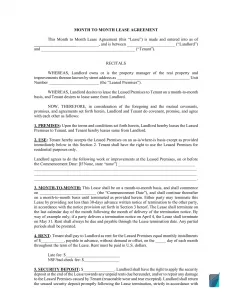
Steps to Filling Out a Monthly Rental Agreement
Step 1—Download your preferred file type.
Download the lease agreement template:
Month-to-month Lease Agreement Template – Adobe PDF (.pdf)
The required PDF editor should already be pre-installed on your computer. If it is, the file should open with ease.
Step 2— Fill out the first paragraph.

Start the month-to-month lease agreement with the following details:
- Blank 1: Type in the full name of the landlord.
- Blank 2: Then, write the full name of the tenant.
Step 3— Complete the opening paragraph of the recitals.
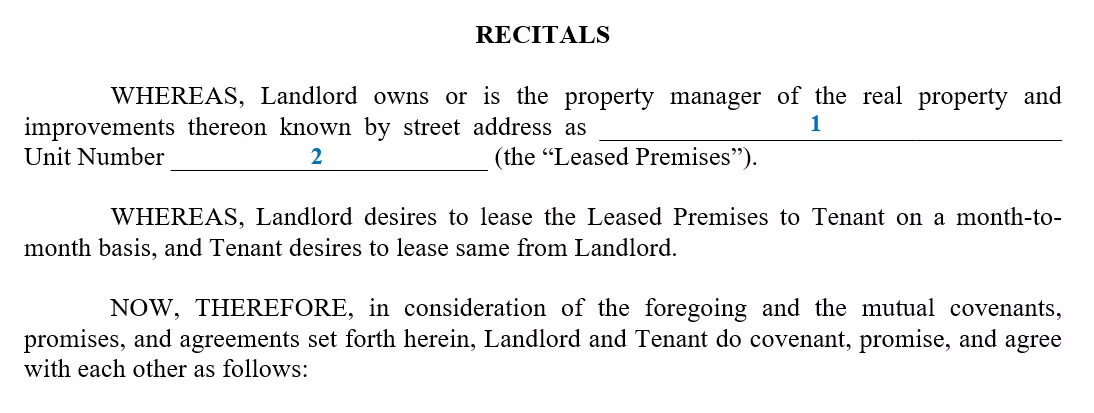
The full address of the premises must be written in detail like so:
- Blank 1: Supply the complete street address (including the floor, house number, street name, county/city, state, and zip code).
- Blank 2: Include the unit or apartment number.
Step 4— Further describe the premises.

Sections 1 and 2 describe the premises that are covered by the month-to-month lease. For the space provided (1), the landlord may describe improvements to be made at the premises before the tenant moves in. If this is not applicable, the landlord may write “none”.
Note: The phrase “As-is where-is basis” means that the premises are accepted by the tenant in their current state. This is common to most month-to-month lease agreements, but the tenant can always request improvements.
Step 5— Write the commencement date.

On the blank provided in Section 3, write the date when the month-to-month lease will begin. Take note that if either the tenant or the landlord decides to terminate the month-to-month lease, they must send a notice 30 days in advance.
Step 6— Provide details about the lease.

Fill out section 4 as follows:
- Blank 1: Write the monthly rent amount, which will cover the month-to-month lease for 30 days.
- Blank 2: Supply the due date of the rent (e.g. “5th”).
- Blank 3: This blank will contain the penalty amount for missed payment deadlines.
- Blank 4: For bounced checks, the landlord may also charge an additional fee. Write this on the blank.
Step 7— Indicate the security deposit.

For a month-to-month lease agreement, a security deposit must be made. This ensures that the tenant will leave no financial obligations behind if ever they leave without advanced notice 30 days before vacating the premises. On blank number 1, write an amount that is anywhere between 50% to 150% of the monthly rent.
Step 8—Describe how the utilities should be settled.
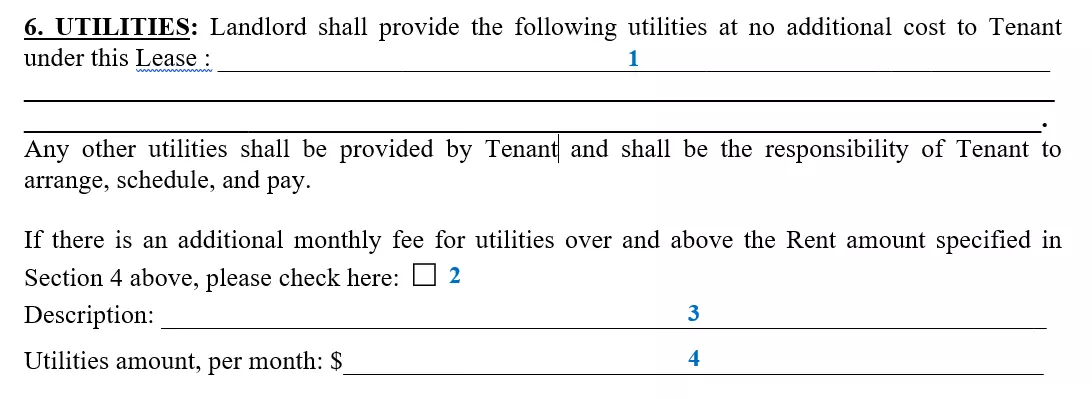
Fill out the following details in section 6:
- Blank 1: Indicate the utilities that are already included in the monthly rent.
- Box 2: If the rent is not inclusive of utilities, the landlord may tick the box (2).
- Line 3: Then, further describe the utilities that the tenant should pay on top of the rent.
- Line 4: Write the total amount for these utilities.
Step 9—Give instructions for maintenance requests.

Blank 1: For the first blank, the landlord must indicate a point person (usually the administrative personnel). This person will receive and attend to maintenance requests during the course of the month-to-month lease. It’s best if you write the full name and address. Meanwhile, the contact number may be optional.
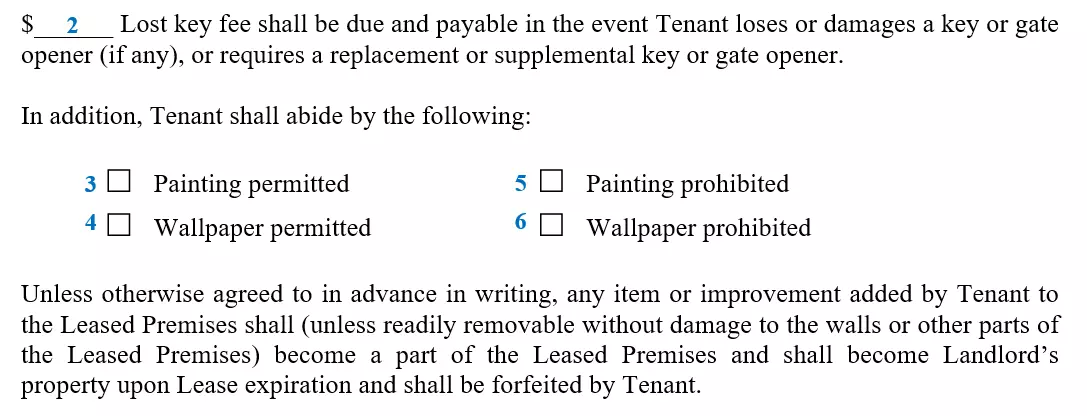
In addition, fill out the following details:
- Blank 2: Indicate a penalty fee for key replacement.
- Box 3 or 5: Tick Box 3 if painting is allowed. Otherwise, tick Box 5.
- Box 4 or 6: Choose Box 4 if the tenant may put up a temporary wallpaper. If not, choose box 6.
Step 10— Review the liability statement.

Section 8 explains that the tenant releases the landlord from any responsibility or liability, except for negligence. For example, landlords of month-to-month rentals may still be responsible for not disclosing any harmful living conditions or not responding to repair requests.
Step 11— Decide about the pet policy.
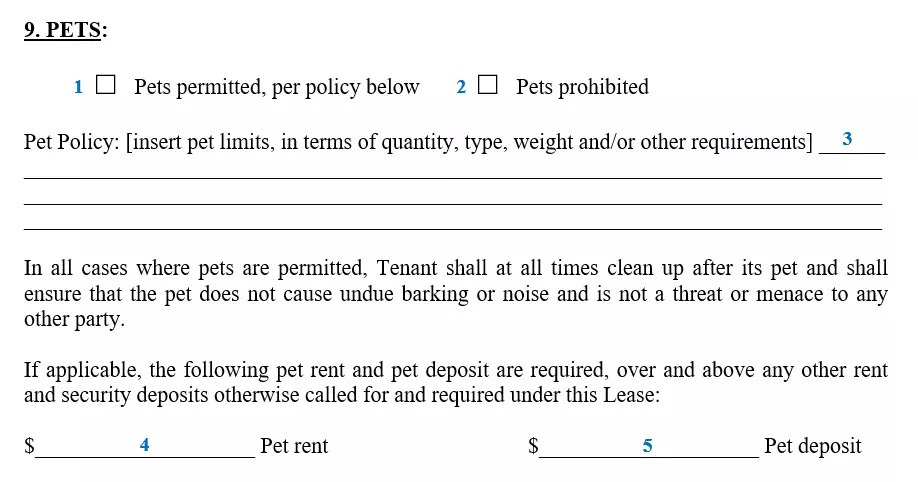
Section 9 explains the month-to-month rental agreement’s pet policy. To be detailed, fill out this like so:
- Box 1 or 2: Tick this box if pets are allowed. Otherwise, tick box 2.
- Blank 3: Indicate the type of pets or breeds allowed. You may also specify any other conditions in this part of the agreement.
- Blank 4: Write the “pet fee” or the additional amount that will be charged to the tenant for keeping pets.
- Blank 5: The landlord may also require a pet deposit amount. Like the primary deposit, the pet deposit will help the landlord repair any damages caused by the pet just in case the tenant leaves without notice.
Step 12— Read the standard clauses.
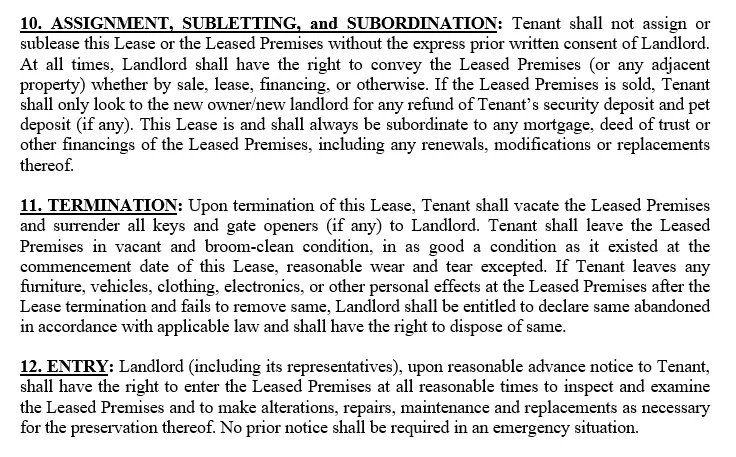
Sections 10 to 11 are standard clauses, but must still be reviewed by both the landlord and tenant. In rare cases, the tenant or the landlord may request a revision. FormsPal highly encourages that they hire an attorney to revise the contract.
Step 13— Write the contact details of the landlord and tenant.
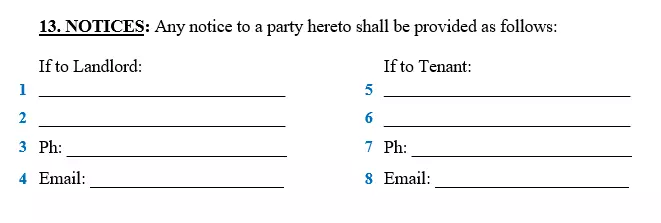
In order to receive notices, the landlord and tenant must indicate their details.
- Blank 1: Write the full name of the landlord or the landlord’s designated representative.
- Blank 2: Indicate the landlord’s residential or office address.
- Blank 3: Write the landlord’s phone or mobile number.
- Blank 4: Lastly, type the landlord’s e-mail address on the blank.
- Blank 5: Write the tenant’s full name or his or her designated representative.
- Blank 6: Indicate the tenant’s residential address. This is usually the address of the premises.
- Blank 7: Write the tenant’s phone or mobile number.
- Blank 8: Finally, write the tenant’s e-mail address on the blank.
Step 14— Describe the parking space.

- Box 1: Tick this box if the month-to-month rental agreement is inclusive of parking fees. If so, identify the allocated parking space on the blank provided.
- Box 2: Tick this box if there is no parking space included in the rental.
Step 15— Read through the rest of the standard paragraphs.

Sections 15 to 20 are standard clauses in both short-term and long-term contracts. Still, these must be fully read and understood by both parties.
Step 16—Sign the contract.
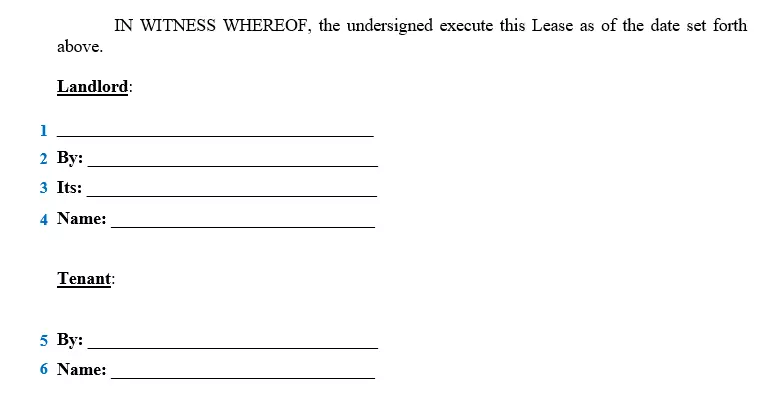
Finally, the landlord and the tenant may sign on the last page of the monthly lease agreement.
- Blank 1: If the landlord is a company, you may write the company name on the first blank.
- Blank 2: Let the landlord’s representative sign on the blank.
- Blank 3: Indicate the position of the representative.
- Blank 4: Write the company representative or simply the landlord’s full name.
- Blank 5: Let the tenant sign on the blank provided.
- Blank 6: The tenant can write his or her full name on the blank.
A month-to-month rental agreement can definitely be ideal for those looking for temporary accommodation. However, like any lease agreement, this type of rental also has its pros and cons. It’s best to weigh the benefits and be prepared for any complications. To ensure that your lease agreement is legal, you may use FormsPal’s fillable form, which you can download above.
